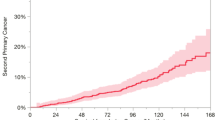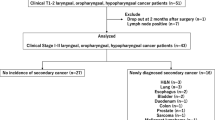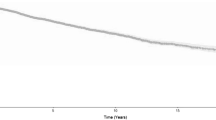Abstract
The incidence of Second Primary Tumors in the upper aerodigestive tract varies from 5 to 30 %. Most of them are located either in the same anatomical region or in the lungs, and are related to a poor overall survival. Our objective is to assess the incidence of Second Primary Tumors, factors related to its outcome, frequent associations, and impact on overall survival. 27 patients with Second Primary Tumors were reviewed out of 307 with head and neck cancer, between 2002 and 2011. Patients had a minimum follow-up period of 3 years, or until their death after the last treatment. Sex: 85.2 % were male; male:female ratio of 23:4. The mean age of appearance for the primary tumor was 66.8 years. Only 1 patient had a synchronous Second Primary Tumor, while 26 had metachronous Second Primary Tumors. Second neoplasms were grouped into synchronous and metachronous for statistical analysis. The following parameters were considered: age at diagnosis of the first tumor, gender, smoking and persistence of the habit, primary tumor’s location in the larynx, association between two squamous cell carcinomas (index and second primary tumor), and radiotherapy for the primary tumor. The incidence of Second Primary Tumors was 8.79 %. Overall survival of metachronous tumors was 95 months (7.9 years). The primary tumor’s location that prevailed when developing a Second Primary Tumor was the larynx. Regarding the histology, the most common association was head and neck squamous cell carcinoma with head and neck squamous cell carcinoma (9 patients). The Second Primary Tumor was the cause of death in 51.9 % of the patients and its most frequent location was the lungs. 19 patients underwent radiotherapy. Second Primary Tumors are common in the head and neck. The authors would like to enforce the importance of an extended follow-up, since second neoplasms worsen considerably the patient’s prognosis. Patients who keep on smoking after treatment decrease even more their overall survival.




Similar content being viewed by others
Abbreviations
- H&N:
-
Head and neck
- CHT:
-
Chemotherapy
- RT:
-
Radiotherapy
- SPT:
-
Second primary tumor
- SM:
-
Smoking
- PT:
-
Primary tumor
References
Gran S, Dahlstrom K, Peck B, Caywood W, Li G, Wei Q, Zafereo M, Sturgis E (2013) Incidence and pattern of second primary malignancies in patients with index oropharyngeal cancers versus index non- oropharyngeal head and neck cancers. Cancer. 119(14):2593–2601
Morris L, Sikora A, Hayes R, Patel S, Ganly I (2011) Anatomic sites at elevated risk of second primary cancer after an index head and neck cancer. Cancer Causes Control 22(5):671–679
López Mollá C, Estellés Ferriola E, Carrasco Llatas M, Seijas Rosales T, Morales Suárez- Varela M, Dalmau Galofre J (2008) Neoplasias malignas múltiples en el cáncer escamoso de cabeza y cuello. Acta Otorrinolaringol Esp 59:427–432
Moertel C, Dockerty M, Baggenstoss A (1961) Multiple primary malignant neoplasms III: tumors of multicentric origin. Cancer 14:231–237
Jones A, Morar P, Phillips D, Field J, Husband D, Helliwell T (1995) Second primary tumors in patients with head and neck squamous cell carcinoma. Cancer 75:1343–1353
Licciardello J, Spitz M, Ki Hong W (1989) Multiple primary cancer in patients with cancer of the head and neck, esophagous and lung. Int J Radiation Oncology Biol Phys 17:467–476
Leong P, Rezai B, Koch W, Reed A, Eisele D, Lee D, Sidransky D, Jen J, Westra W (1998) Distinguishing second primary tumors from lung metastases in patients with head and neck squamous cell carcinoma. J Natl Cancer Inst 90(13):972–977
Geurts T, Nederlof P, Van den Brekel M, Van´t Veer L, Jong D, Hart A, Van Zandwijk N, Klomp H, Balm A, Van Velthuysen M (2005) Pulmonary squamous cell carcinoma following head and neck squamous cell carcinoma: metastasis or second primary? Clin Cancer Res 11(18):6608–6614
Yamamoto E, Shibuya H, Oshimura R, Miura M (2002) Site specific dependency of second primary cancer in early stage head and neck squamous cell carcinoma. Cancer 94:2007–2014
Sánchez Zamorano L, Hernández Avila M, Lazcano Ponce E (2006) El consumo inmoderado de alcohol como factor predictor de la persistencia del consumo de tabaco en jóvenes. Salud pública de México 48(1):S41–S47
Larson T, Adams G, Fatah H (1990) Survival statistics for multiple primaries in head and neck cancer. Otolaryngol Head Neck Surg 103:14–24
Vikram B (1984) Changing patterns of failure in advanced head and neck cancer. Arch Otolaryngol. 110:564–565
Pardo H, González Aguilar O, Pereyra A, Marolda S, Rubino A, Simkin D (2008) Cáncer de cabeza y cuello. Impacto pronóstico de los 2° y 3° primarios. Rev Argent Cirug 95:205–219
Álvarez Marcos C, Llorente Pendás J, Franco Gutiérrez V, Hermsen M, Cuesta Albalad M, Fernández Espina H et al (2006) Segundos tumores primarios en el cáncer escamoso de cabeza y cuello. Acta Otorrinolaringol Esp 57:462–466
Graff P, Schipman B, Desandes E, Mecellem H, Toussaint B, Cortese S et al (2011) Management of patients with head and neck tumors presenting at diagnosis with a synchronous second cancer at another anatomic site. Clin Oncol (R Coll Radioll). 23:174–181
Farhadieh R, Otahal P, Taghavi K, Salardini A, Russell P, Smee R (2011) Second primary tumors of the head and neck are not associated with adverse overall survival in oral squamous cell carcinomas. J Cancer Sci Ther 3:30–34
Argiris A, Brockstein B (2004) Competing causes of death and second primary tumors in patients with locoregionally advanced head and neck cancer treated with chemoradiotherapy. Cl Cancer Res 10:1956–1962
Robinson E, Neugut A, Murray T, Rennert G (1991) A comparison of the clinical characteristics of first and second primary head and neck cancers. Cancer 68:189–192
Dolan R, Vaughan C, Fuleihan N (1998) Metachronous cancer: prognostic factors including prior irradiation. Otolaryngol Head Neck Surg 119:619–623
León X, Martínez V, López M, García J, Venegas M, Esteller E et al (2012) Second, third, and fourth head and neck tumors. A progressive decrease in survival. Head Neck 34:1716–1719
Franco Gutierrez V, Álvarez Marcos C, Llorente J, Guervós M, Iglesias M, Tamargo L et al (2012) Genetic profile of second primary tumors and recurrences in head and neck squamous cell carcinomas. Head Neck 34:830–839
Gallegos Hernández F (2006) El cáncer de cabeza y cuello. Factores de riesgo y prevención. Cir Ciruj 74:287–293
Slaughter D, Southwick H, Smejkal W (1953) Field cancerization in oral stratified squamous epithelium. Clinical implications of multicentric origin. Cancer 6:963–968
León X, Quer M, Diez S, Orús C, López-Pousa A, Burgués J (1999) Second neoplasm in patients with head and neck cancer. Head Neck 21:204–210
Kiyoto S, Masaru T, Katsunori K, Ayako N, Takenori O, Yukinori A et al (2011) Distinct features of second primary malignancies in head and neck cancer patients in Japan. Tohoku J Exp Med 225:5–12
Wang Z, Sturgis E, Zhang F, Lei D, Liu Z, Xu L et al (2012) Genetic variants of p27 and p21 as predictors for risk of second primary malignancy in patients with index squamous cell carcinoma of head and neck. Mol Cancer 11:17
Zhang Y, Sturgis E, Huang Z, Zafereo M, Wei Q, Li G (2012) Genetic variants of the p53 and p73 genes jointly increase risk of second primary malignancies in patients after index squamous cell carcinoma of the head and neck. Cancer 118:485–492
Lin K, Patel S, Chu P, Matsuo J, Singh B et al (2005) Second primary malignancy of the aerodigestive tract in patients treated for cancer of the oral cavity and larynx. Head Neck 27:1042–1048
Vaamonde P, Martín C, del Río M, LaBella T (2003) Second primary malignancies in patients with cancer of the head and neck. Otolaryngol Head Neck Surg 129:65–70
Liao C, Kang C, Chang J (2007) Survival of second and multiple primary tumors in patients with oral cavity squamous cell carcinoma in the betel quid chewing area. Oral Oncol 43:811–819
Conflict of interest
Marina V. Aramendi and Marta S. Patrucco did not have conflicts of interests when performing this research.
Author information
Authors and Affiliations
Corresponding author
Rights and permissions
About this article
Cite this article
Patrucco, M.S., Aramendi, M.V. Prognostic impact of second primary tumors in head and neck cancer. Eur Arch Otorhinolaryngol 273, 1871–1877 (2016). https://doi.org/10.1007/s00405-015-3699-1
Received:
Accepted:
Published:
Issue Date:
DOI: https://doi.org/10.1007/s00405-015-3699-1




